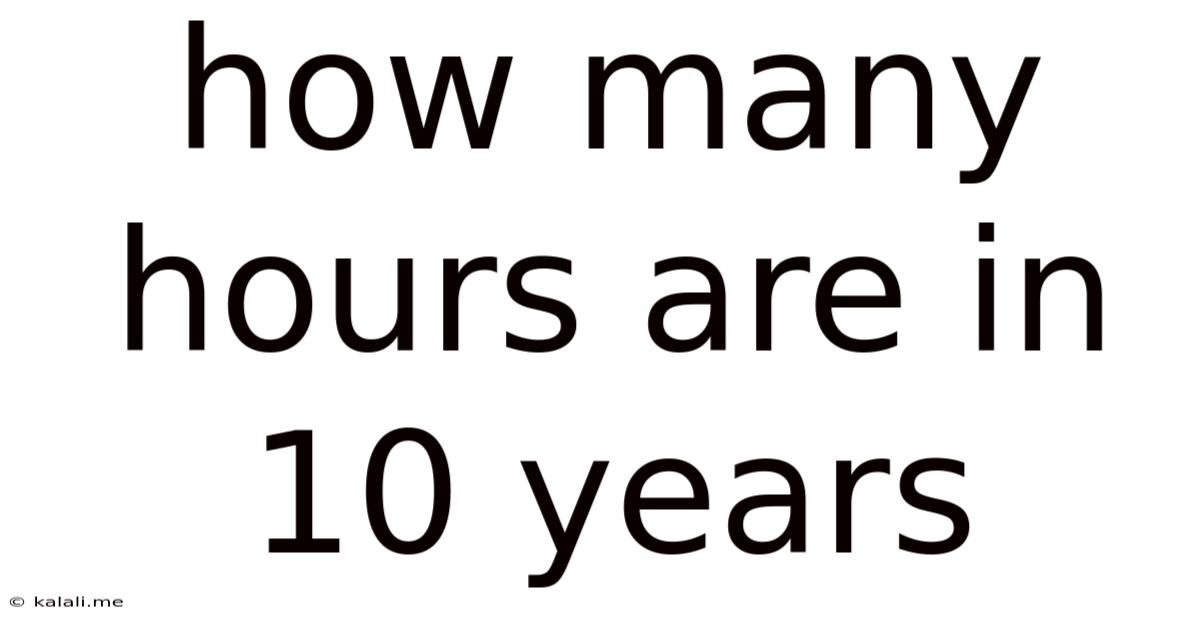How Many Hours Are In 10 Years
Kalali
Jul 12, 2025 · 4 min read

Table of Contents
How Many Hours Are in 10 Years? A Deep Dive into Time Calculation
This article will explore the seemingly simple question: how many hours are in 10 years? While the basic calculation is straightforward, we'll delve deeper into the complexities of time, exploring leap years, variations in day length, and the broader implications of understanding large time spans. This comprehensive guide is perfect for anyone curious about the vastness of time or needing a precise calculation for a specific application.
Understanding the Fundamentals: A Simple Calculation
The most straightforward approach to calculating the number of hours in 10 years involves multiplying the number of days in a year by the number of hours in a day, and then multiplying by 10. A standard year has 365 days, and each day contains 24 hours. Therefore:
365 days/year * 24 hours/day = 8760 hours/year
8760 hours/year * 10 years = 87,600 hours
This gives us a preliminary answer of 87,600 hours. However, this calculation is a simplification that doesn't account for leap years.
Accounting for Leap Years: Refining the Calculation
The Gregorian calendar, which is the most widely used calendar system worldwide, incorporates leap years to account for the Earth's slightly longer than 365-day orbital period. A leap year occurs every four years, except for years divisible by 100 but not by 400. This means that the years divisible by 4 are leap years unless they are also divisible by 100 but not by 400.
To accurately calculate the number of hours in 10 years, we need to determine how many leap years fall within that decade. Let's consider a 10-year period, say from 2024 to 2033:
- 2024 is a leap year (divisible by 4)
- 2028 is a leap year (divisible by 4)
- 2032 is a leap year (divisible by 4)
Therefore, there are three leap years in this 10-year period. Each leap year has 366 days, adding an extra 24 hours to the total.
The calculation becomes:
(7 years * 365 days/year * 24 hours/day) + (3 years * 366 days/year * 24 hours/day) = 87648 hours
This gives us a more precise answer of 87,648 hours for the specific 10-year period of 2024-2033. The number of leap years will vary depending on the specific 10-year period chosen.
The Subtlety of Time: Variations in Day Length and Atomic Clocks
Even our refined calculation is an approximation. The Earth's rotation isn't perfectly uniform. The length of a day can vary slightly due to various factors, including the gravitational pull of the moon and sun, and the movement of the Earth's core. These variations are tiny, but they accumulate over time.
To achieve the highest possible accuracy, scientists use atomic clocks, which measure time based on the vibrations of atoms. Atomic clocks are incredibly precise, far surpassing the accuracy of calculations based on the Earth's rotation. However, even atomic clocks have limitations and require periodic adjustments.
The difference between a calculation based on the Gregorian calendar and the actual measured time using atomic clocks is minuscule over a 10-year period, but it's important to acknowledge that the concept of "a day" isn't perfectly constant.
Applications and Implications of Understanding Large Time Spans
Understanding the number of hours in 10 years, and the complexities involved in this calculation, has various practical applications:
-
Project Planning: Large-scale projects often require detailed time estimations. Knowing the total number of working hours available in a project's timeframe is crucial for resource allocation and scheduling.
-
Financial Modeling: Calculations involving interest rates, investments, and amortization often require precise time calculations to accurately predict future values.
-
Scientific Research: Many scientific studies, especially those involving long-term observations or experiments, require careful consideration of time spans to interpret data correctly.
-
Data Analysis: Working with large datasets that span years often requires converting time units for analysis and visualization.
-
Personal Productivity: While seemingly less significant, understanding large time spans can help individuals visualize the vast amount of time available to achieve long-term goals and enhance personal productivity.
Beyond the Numbers: The Philosophical Significance of Time
The act of calculating the number of hours in 10 years goes beyond a simple mathematical exercise. It forces us to contemplate the vastness of time and our place within it. Ten years represents a significant portion of a human lifespan, representing potential achievements, personal growth, and profound change.
The calculation highlights the fleeting nature of time and the importance of making the most of each hour. It's a reminder to be mindful of our time and to pursue goals with intentionality and purpose.
Conclusion: A Deeper Appreciation for Time
While the initial answer to "How many hours are in 10 years?" seems simple – around 87,600 – a deeper dive reveals the complexity inherent in accurately measuring and understanding time. Accounting for leap years, variations in day length, and the limitations of our calendar systems provides a more nuanced perspective. The calculation itself serves as a powerful reminder of the passage of time, its significance, and the need for careful planning and mindful living. Ultimately, understanding this calculation provides not only a numerical answer but also a deeper appreciation for the vastness and value of time itself.
Latest Posts
Latest Posts
-
Jello Instant Pudding Pie Recipe On Box
Jul 12, 2025
-
How Do You Make 2 3 Of A Cup
Jul 12, 2025
-
Closest Gulf Beach To Kentucky From My Location
Jul 12, 2025
-
How Many 16oz Water Bottles Make A Gallon
Jul 12, 2025
-
What Is Half Of 1 3 4
Jul 12, 2025
Related Post
Thank you for visiting our website which covers about How Many Hours Are In 10 Years . We hope the information provided has been useful to you. Feel free to contact us if you have any questions or need further assistance. See you next time and don't miss to bookmark.